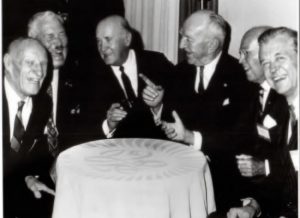
Predictions of a Pioneer
Igor Sikorsky’s predictions for air travel in general and for helicopters in particular have been largely realized or surpassed.
Igor I. Sikorsky’s VS-44A was a large transport aircraft with a wingspan of 124 feet, an overall length of about 80 feet and a gross weight of 57,500 pounds. It was powered by four Pratt & Whitney Twin-Wasp radial engines that produced a combined 4,800 horsepower for take-off and a cruise speed of about 210 miles per hour. Her nonstop range, depending on load and the quantity of fuel, was approximately 4,000 miles, which was unmatched performance for the time. In the summer of 1940 American Export Airline (AEA) ordered three VS-44A’s at a total cost of $2,100,000. These aircraft were dubbed the “Flying Aces” by AEA and named the Excalibur, Excambian and Exeter. AEA advertising boasted minimum vibration, maximum sound-proofing, individual sofas, full length beds, roomy dressing rooms, full galley for serving hot meals, snack bar service, attractive lounge and smoking room, proper heating and ventilation and more square foot area per passenger. No other contemporary aircraft had these luxuries. AEA signed a contract with the Naval Air Transport Service to operate a wartime trans-Atlantic route in January, 1942. On May 26 the Excalibur made the maiden nonstop flight from New York to Foynes, Ireland and on June 20 regular round trip service began. The Flying Aces proved to be the world’s longest range airliners and set record after record. They were the only aircraft capable of flying nonstop across the North and South Atlantic at full payload in excess of 3,100 miles.
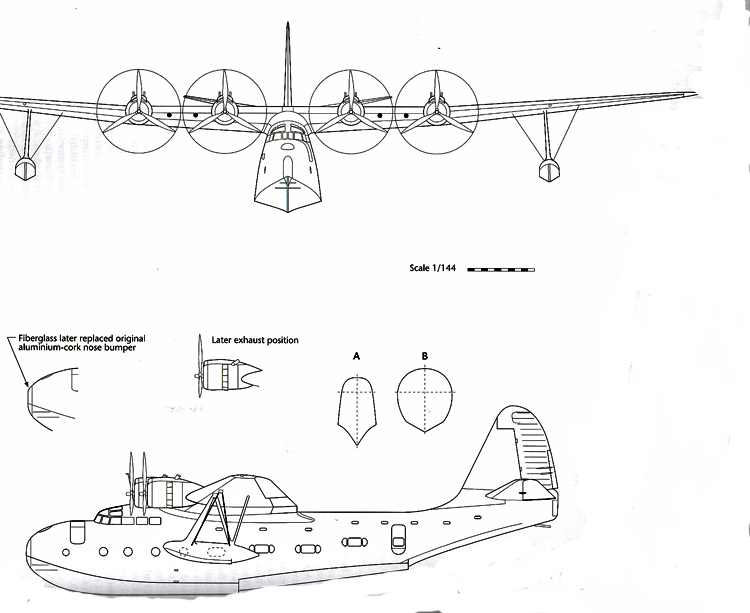
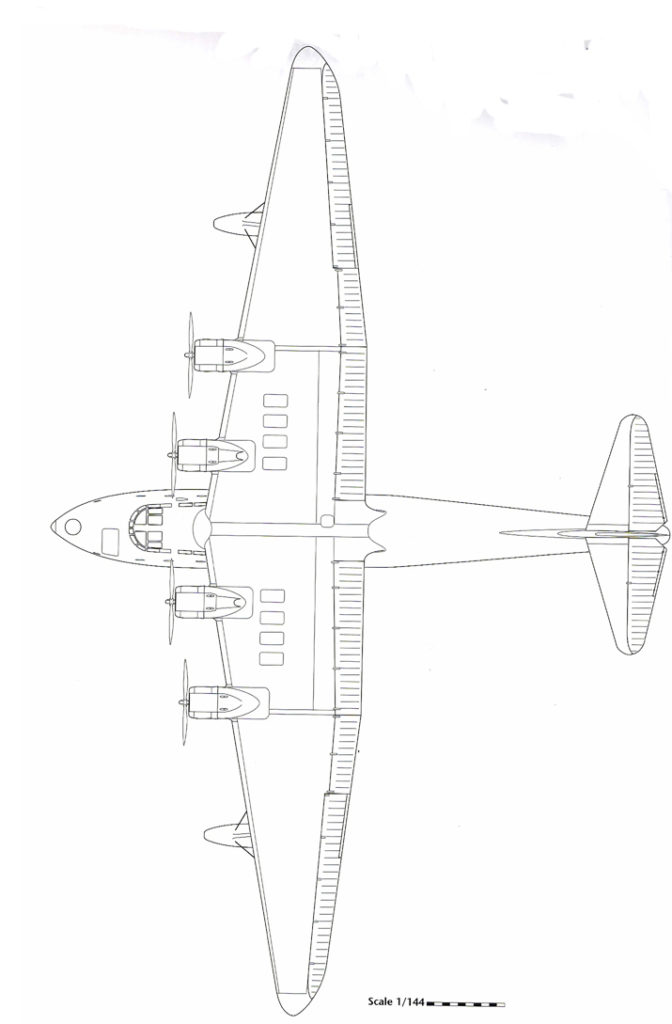
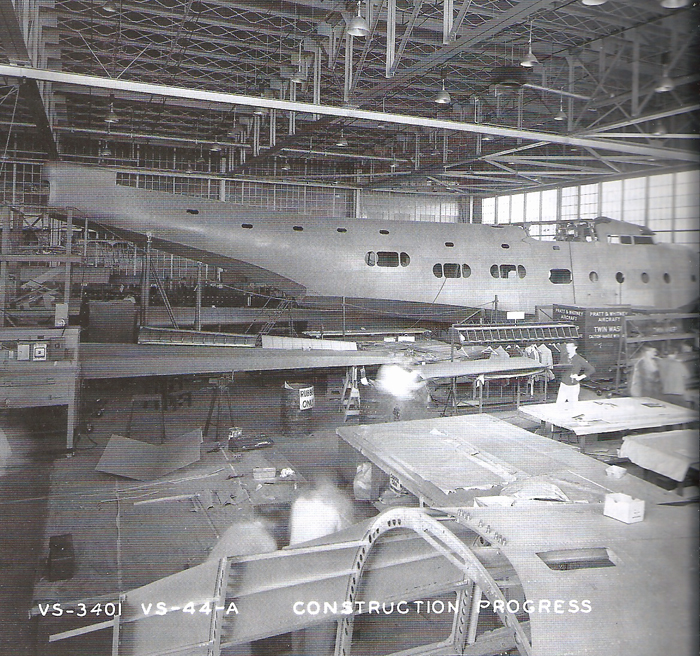
In December 1939, American Export contracted with Vought-Sikorsky for the design and engineering of a commercial version of the XPBS-1 flying boat, with an option to purchase three aircraft.
In July 1940, when AEA received permission from Civil Aeronautics Board to commence trans-Atlantic passenger service, it immediately exercised the option flying boats. A contract was quickly executed between Sikorsky and AEA wherein three VS-44A aircraft would be built for the total price of $2,100,000.
Design work on the VS-44As began in February 1940 and construction of the three aircraft began almost immediately. They were destined to be christened Excalibur, Excambian and Exeter in honor of the three front-line cargo vessels owned by American Export’s shipping division. Just as the cargo vessels were known as “Aces,” the three aircraft became affectionately known as the “Flying Aces.”
Officially, the three aircraft were designated as follows:
| Number | Name | Tail Number | Mfg. Number |
|---|---|---|---|
| 1 | Excalibur | NC 41880 | 4402 |
| 2 | Excambian | NC 41881 | 4403 |
| 3 | Exeter | NC 41882 | 4404 |
VS-44A aircraft dimensions are provided in the following table:
| VS-44A Dimensions | |
|---|---|
| Wing span | 124 ft. |
| Height over nacelles (Deck line level) | 16 ft. 7 in. |
| Height over tail | 27 ft. 7.25 in. |
| Height over propellers on beaching gear | 24 ft. 0 in. |
| Height over keel to sling in high position | 21 ft. 3 in. |
| Length overall | 79 ft. 3 in. |
| Dihedral center section | 2 degrees |
| Dihedral | 5 degrees |
| Chord center section maximum | 20 ft. 0.5 in. |
| Incidence of wing | 5 degrees |
| Span of tail | 31 ft. 0 in. |
| Adjustment of stabilizer | Fixed |
| Gross displacement of hull | 268,800 lbs. |
| Length of hull | 79 ft. 3 in. |
| Beam of hull | 10 ft. 0 in. |
| Height of hull to deck line | 11 ft. 11 in. |
| Diameter of propellers (3-blade) | 12 ft. 6 in. |
| Tread of wing tip floats | 78 ft. 0 in. |
| Maximum draft | 3 ft. 8 in. |
| Maximum draft with beaching gear attached | 6 ft. 2 in. |
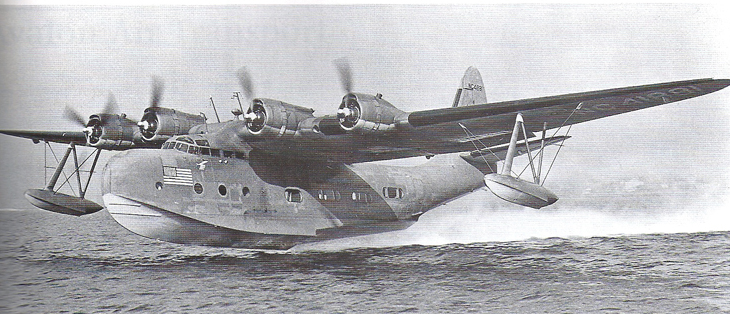
On May 26 the Excalibur made the maiden nonstop flight from New York to Foynes, Ireland and on June 20 regular round trip service began. The Flying Aces proved to be the world’s longest range airliners and set record after record. They were the only aircraft capable of flying nonstop across the North and South Atlantic at full payload in excess of 3,100 miles. The Excambian is the only example remaining today.
In 1950 a group from Baltimore rebuilt the Excambian to carry freight to Amazon River natives. Their plan failed which stranded the Excambian in Ancon Harbor near Lima, Peru. In 1957 Avalon Air Transport ferried the aircraft to California where she shuttled thousands of tourists between Long Beach, California and nearby Catalina Island. In 1968 Antilles Air Boats acquired the Excambian to ferry passengers among the Virgin Islands. Later in 1968 she was extensively damaged and retired from service. In 1976 Antilles President Charles Blair and his Wife, Maureen O’Hara, donated the aircraft to the Naval Aviation Museum at Pensacola, Florida. The Naval Aviation Museum eventually put her on permanent loan to the New England Air Museum.
The forward section of the hull houses the crew and includes sleeping accommodations for five crew members, the galley, mooring equipment, baggage storage space, and two men’s rooms. The center portion of the hull is given over to passenger accommodations. The stern portion is arranged for a ladies’ powder room, baggage storage and accommodations for a stewardess. An interphone system enables the pilot to communicate with a member of the crew, whether he is in the bow, at the mooring hatch, or at the extreme stern of the hull.
The passenger cabin is equipped with individual seats 40 inches wide and having adjustable cushions; full view windows, individual reading lights, and a complete heating and ventilation system. The seats are quickly convertible into comfortable beds. Upper berths are equipped with windows and reading lights. The men’s lavatories and ladies’ powder rooms are equipped with hot and cold water and complete toilet facilities. Provisions are made to accommodate three ten-person inflatable life rafts. As passenger comfort is a primary concern the aircraft specifications allow for 400 pounds of soundproofing and fabric panels to keep the sound level at or below 85 decibels.
“Equivalent to a bridge of a surface vessel, the flight deck houses the operating crew of the airplane. The operating crew consists of a pilot and co-pilot, a navigator, a radio operator, and a flight engineer who controls the operation of the engines and also controls an independent power plant generating electricity for the many electrically operated units in the airplane.

Igor Sikorsky’s predictions for air travel in general and for helicopters in particular have been largely realized or surpassed.
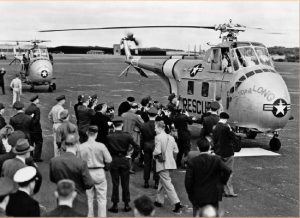
This issue of the newsletter recognizes the anniversaries of a VS-44A flying boat setting a record for crossing the Atlantic non-stop; S-55 helicopters self-deploying to Europe; and S-61 helicopters flying non-stop to Paris.
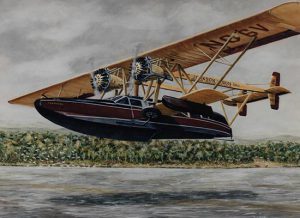
This issue of the newsletter illustrates some of the artistic variations in the exterior color schemes of aircraft delivered during Igor Sikorsky’s three careers.
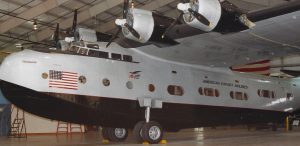
During the 1980s, a dedicated group of volunteers restored the VS-44A Excambian for the New England Air Museum
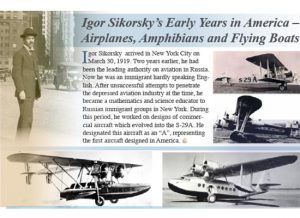
Igor Sikorsky’s developed aircraft, amphibians and flying boats during his early years in America.